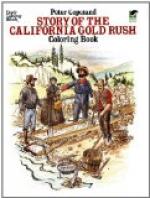Florists who raise flowers to sell find that here they can grow the choicest and finest carnations, roses, and all the garden blossoms you know so well. Many of these florists deal only in flower-seeds, and bulbs or roots of the lilies to send to the Eastern states or abroad, where people greatly prize California flowers.
Plants and trees from all parts of the world thrive here, also. You have seen the palms, the tall sword-palm with its great spike of snowy bloom in the spring, the fan-palm whose dried and trimmed leaves are really used for fans, and, perhaps, the date-palm. This tree was planted round the Missions by the Padres, and some, more than a hundred years old, are still standing at the San Gabriel Mission. These, and the magnolia with its large creamy blossoms, as well as the graceful pepper-tree, are natives of warm, southern lands, while the eucalyptus, or gum-tree, was brought here from Australia.
Look round, children, as you walk to and from school, or in the park, and try to know and name the green things growing there, the flowers and plants sent to make our world a pleasant place to live in.
THE BIG TREES AND LUMBERING
The largest trees in the world are those forest giants of California which grow on the western slopes of the Sierra Nevadas, and nowhere else on the globe. People carelessly call these grand trees “redwoods” or “big trees,” but their family name is Sequoia, an Indian chief’s name. When the trees were first discovered, in 1853, accounts of their height and size were sent to England. Supposing this giant to be a new tree, it was there christened Wellingtonia, and also gigantea for its immense measurements. While Americans were trying to have it called Washingtonia, a famous Frenchman who knew all about trees decided that the specimen sent him was certainly a sequoia, as named by a German professor some six years before this time. So the tree was called sequoia gigantea and quietly went on growing, unmindful of the four nations who had quarrelled over its christening. Why, indeed, should it bother its lofty head with the chatter of people whose countries were unknown when this mighty tree was full grown? For these sequoias are the oldest of living objects and have probably been growing for four thousand years. How do we know this? Well, when a fallen trunk is sawed across, one can see rings in the wood, and it is thought that each ring is a year’s growth. John Muir counted over four thousand of these annual rings on the stump of one of the Kings River trees.
These fine old trees grow in groves, and of the nine or ten groves the Calaveras and Mariposa are the best known. The Calaveras group of nearly a hundred mighty trees was the first one discovered, and four trees here are over three hundred feet high. The fallen “Father of the Forest” must have been much higher, for it measures a hundred feet round its trunk at the root end. A man can ride on horseback for two hundred feet through its hollow trunk as it lies on the ground. Many of the standing trees hollowed out by fires are large enough, used as cabins, to live in.




